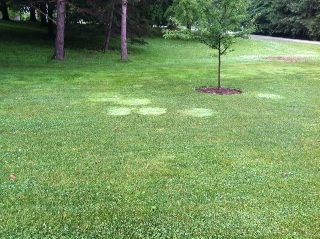It is difficult to be sure, without the help of a close-up, but if the patches look like this or this, the problem is likely to be Poa Trivialis.
Poa trivialis is a perennial grass that spreads by stolons forming light green patches in the turf. It is best adapted to shady, moist, or overwatered sites, and because of this, it often appears in mixtures with Kentucky bluegrass and perennial ryegrass recommended for shady areas. Two theories persist about how Poa trivialis is introduced to a turf stand. Some believe that Poa trivialis grows naturally over most of the world and Poa trivialis seeds or stolons can germinate after lying dormant for many years, thus contaminating a turf stand. Others believe that it is introduced as a contaminant in turf seed and seed producers growers have since self-imposed Poa trivialis growing and shipping restrictions to help prevent this.
Control
There is no selective control of Poa trivialis today, though scientists are trying to
develop one. Nonselective control with glyphosate or glufosinate followed by
reseeding may offer the best chance of control.
Article by Purdue University
Apparently, its growth can be discouraged by deep but infrequent watering, good drainage, mowing 3" or above and heavy traffic.




